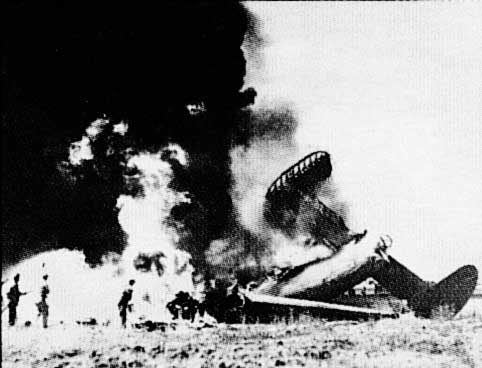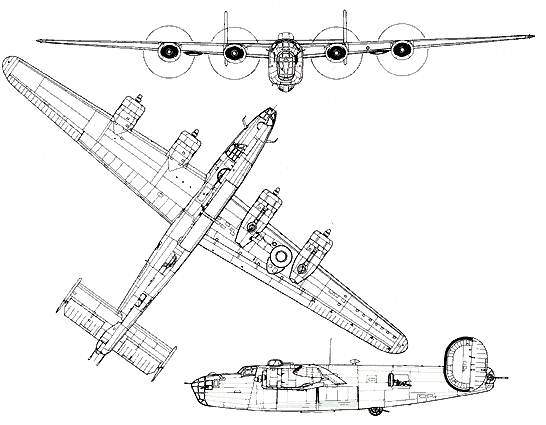



The Consolidated B-24 WWII Liberator Heavy Bomber
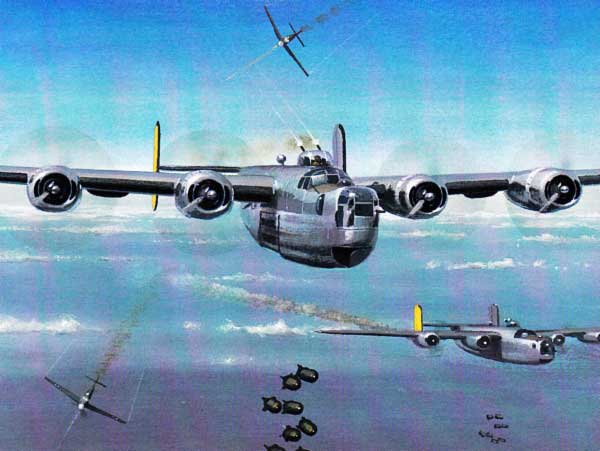
Towards the end of the war, Rosie and friends were knocking out a B-24 Liberator Heavy Bomber every 100 minutes AND they built over 18,000 in all!! You'll enjoy about twice as much time of modeling fun building this one. Cyber Model is best when printed on sheets of aluminum colored paper with a laser printer.
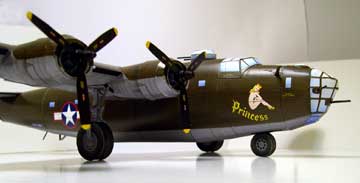 B-24 Liberator Heavy Bomber |
History of these beautiful birds.
In time of war, the finest bomber design is of little value unless
it can be produced easily and in sufficient numbers. Mass production
became the order of the day and American Industry excelled at it!
At the Consolidated Vultee facility at San Diego, CA. Liberators
were moving along at 8 1/2 inches per minute. This plant turned
out more than 6,500 of these bombers. Altogether, 18,482 Liberator
bombers were built- nine major variants- a vastly greater number
than any other heavy bomber type.
This is the Consolidated B24 model that won the FG Modeling Madness (FGMM) 2010 best in class prize. |
|
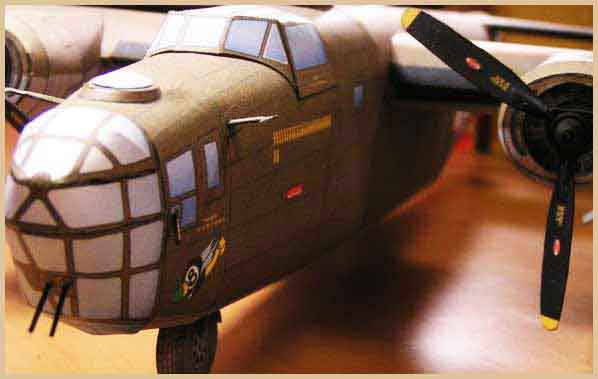 |
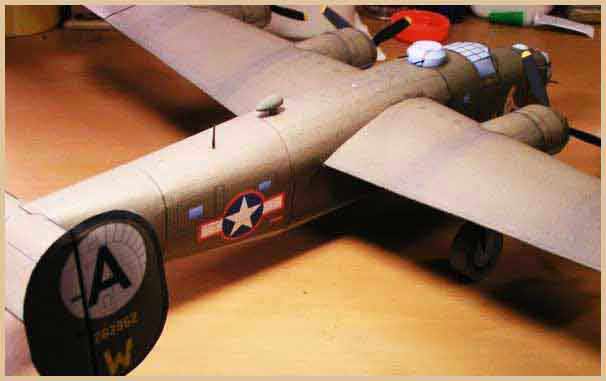 |
My friend Raymond Dugdale, who has fought in both WWII and the Korean War, told me a story about his encounter with David R. Davis, the engineer who designed the Davis wing section. This design was used in the B-24 made by Consolidated. When Raymond was young he made model airplanes, and also silhouettes used for aircraft recognition by the War pilots. He lived in Butte, Montana, and mowed lawns, one of which was for Mr. Owsley, the druggist. Mr. Owsley’s daughter was in one of Raymond’s classes. She was also a friend of Mr. Davis’s daughter, whom she invited for a visit. Word got out that Raymond was making models, and Mr. Davis came out to talk to Raymond. He offered to give him the specs for his wing section, which he claimed was much better than others. Raymond accepted his gracious offer, especially since he was entered into a model airplane competition for the next day. Raymond worked that night to replace his model’s wings with wings of the same size of Mr. Davis’s dimensions. He entered his new model into the competition the following day. His airplane flew high, and kept on flying until it was out of sight. It never was seen again. Needless to say, Raymond won that competition. - by Tama Genovese
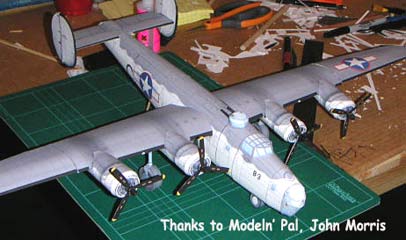 As
you know, many B-24's were made here in Michigan at Willow
Run, about an hour's drive from where I live now; near Selfridge
ANG Base in Mt. Clemens. We Michigainians have a soft spot
for B-24's, I remember as a young lad watching hundreds
fly over our house after leaving the assembly plant at Willow
Run
As
you know, many B-24's were made here in Michigan at Willow
Run, about an hour's drive from where I live now; near Selfridge
ANG Base in Mt. Clemens. We Michigainians have a soft spot
for B-24's, I remember as a young lad watching hundreds
fly over our house after leaving the assembly plant at Willow
Run
With a little altering of the nose, it would be easy to make B-24J's as well. Just think of all the different nose art models one could fit on a CD. And don't forget assembly ships, their to colorful to leave out. Just going to have to buy the CD when it comes out. It will be just like waiting for the DVD of the Aviator. Thanks Don Kenske
Thanks for the help with the B-24 model. I downloaded it and it looks great. (I have already started on "Strawberry" of course. :-) You guys are the best!.......-Mark
Just a few lines to say thanks for the B-24s, I'm new to card modeling and 'Gramps' was only my second attempt, so my effort doesn't look fantastic (down to me) but my 2 1/2 year-old daughter thinks it's great! (get them while they're young) Gets hours of amusement 'flying' around the house, I also think she uses it to beat the dog, then brings it into me for rapid repair - so far new port wing, tail and nose - all good practice - couldn't see myself letting her lose with a plastic kit. Regards-nick
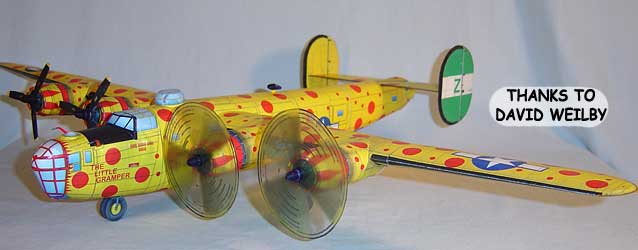
These '24's are REALLY smooth and classy.....Cliff in Odessa, TX
Thank you for the B-24! As usual, John Dell at his best. Hope to see more 'big aircraft' either military or civilian version. Keep it up. Regards,...Kit
Chip, Thank you! These are beautiful! --David
How about the B-24's turned into cargo aircraft flying over the Hump into China? My father-in-law road on them a few times. They took off the guns and closed things up. Not a very fun mission, but a lot of people depended on the supplies. Dennis
.....You know, I just remembered that it's thanks to paper models that I've become lots closer to my father-in-law in the last several years. He's a very conservative, closed mouth guy, and for a long time we both assumed that we had absolutely nothing in common. One summer while visiting I pulled out the FG model of the B-24 and started to work on it. Stan, my father-in-law, looked over my shoulder and said that he was a ground-crew chief for B-24's during WWII here in the US. "Really? Tell me more!" Well, he started talking about the planes, unauthorized flights around the field, company buddies, trips to town, etc. Turned out he was a treasure trove of experiences and stories, most of which my wife had never heard before! As a young man from coal country in rural Pennsylvania, where Polish was spoken at home and at church, the war was quite an eye-opener for him. Further, he was thrilled to have found someone eager to listen to these dusty old tales. Over the next few days he pulled out old photo albums, citations, and a box full of memorabilia he had not looked at in nearly 50 years. We had a grand old time, and in the last few years the two of us have gone to the New England Air Museum several times times together. Planes turned out to be the common ground we needed on which to build a friendship, and now we get along quite nicely. (I gave him the B-24 when I was finished, and for a long time it hung from the ceiling over the dining room table.) Kell Black (12/16/01)
Thanks for the liberator model, it looks great with clear
windows as a mobile with ww2 fighters hanging from wings,
nose and tail, my 6-year old loves it....Glen 12/03
I am just finishing the B-24 kit. I am really pleased with the model. It looks great. I am going to give it to an old B-24 bomber pilot on his birthday next month. I am also going to give him a copy of your historical information. Thanks for the nice models! Stan Zdziarski
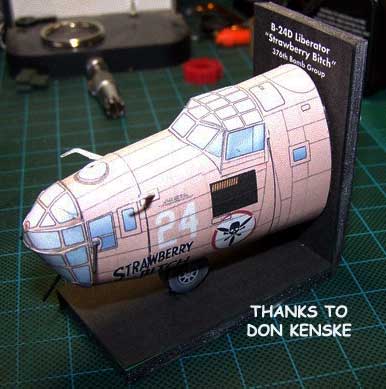 This "Strawberry Bitch" Nose model is included in the Consolidated B-24 folder |
I am thrilled to see a B 24 version of the Strawberry Bitch available! I have started working on the black and White version as a way to "work up" to the 'Bitch. I have always had a small interest in modeling when I was quite a bit younger, but was never very good having to paint plastic models and find working in cardstock to be very relaxing and stress relieving!
My father, "Andy" Giordano was a nose gunner ( B-24J model- Emerson Turret) with the 513th Squadron of the 376th Bomb Group during 1944 and 1945. Dad is alive and well at 83 years old. About 1997, I started to locate former members of his crew and was surprised that I couldn't find any information about them online, so I built a web site for the Group and was webmaster from 1998 to 2003. I gave the position up for a bit, but recently returned as webmaster. I am anxiously awaiting Johns "J' model version, as this was what my father flew most of his missions in! Sincerely, Robert J. Giordan Website Coordinator webmaster@376hbgva.com
Word is getting around! At our yearly IPMS contest, I overheard one of the registration guys suggesting to a father and his two young sons that a good way to get into modeling is to start with paper ones, he specifically recommended fiddlersgreen. I interrupted and told the father to check out the one I was entering to see what they were like.
The registration guy asked what I had, I told him John Dell's B-24, he said Strawberry Bitch, I said, yup. He said he had that one hanging in his basement as well. They still make me enter in the Miscellaneous category, though. I took second place again this year, lost out to a bridge (it was really big).
After the show was over, one of the judges came over and said that there was a big discussion as to whether the B-24 should get first place, as he said that they are familiar with what it takes to make a really good paper model. So, I guess we're converting some of the plastic modeling guys, now. Plus, you ever check out the price of some of those? I don't think I'll ever be buying one anymore! Neal
My children (three little boys) and I are really exiting to build this pink (Strawberry Bitch) bomber !
Thank you again for your cooperation and I will order other model cards next months.
Let me know about your production and if you create new models.
You did a great job. Best regards, Jean-Michel
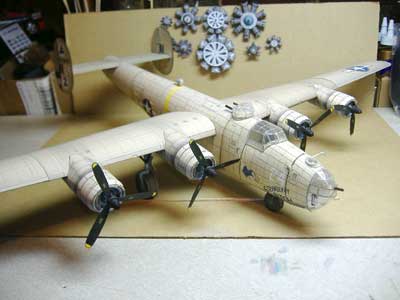 |
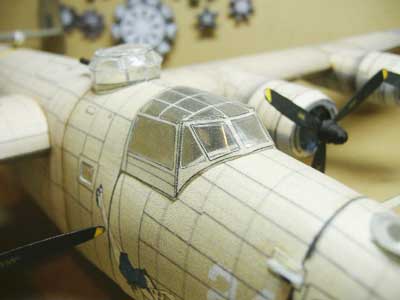 |
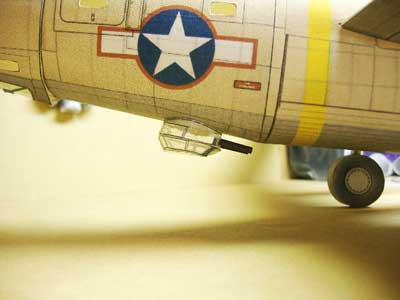 |
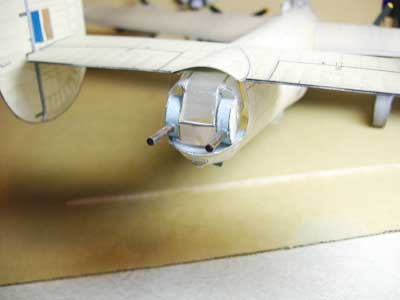 |
Had to send you this one with all clear tape windows. Bob Martin. Thanks Bob! |
|
|
Although overshadowed by the B-17 Flying Fortress, the Liberator had a number of virtues that made it a much more sought after bomber: It was fast (300 mph at 30,000 feet), capable of carrying 8000 LB of bombs, and had an operational range of approximately 2290 miles. The prototype XB-24 flew in 12/39 and the first deliveries were made 1941 to the RAF. It's worth was soon realized when it served as a reconnaissance aircraft, submarine bomber, VIP transport, and ferried pilots and personnel across the North Atlantic.
Heavily armed and possessing long range, the Mighty B-24 Liberator helped the Allies to take and maintain control of the vital seaplanes. |
Liberators dropped more than 635,000 tons of bombs on Europe, Africa. and the Pacific and shot down 4,189 enemy aircraft. In combat the B-24 tended to burn more easily than the B-17, and when damaged, was inclined to break up during a wheels-up landing. This was due to its very complex construction: In particular, the wing was relatively weak and in many cases, if hit in the crucial places, it gave away completely. Photographic records of WWII show B-24s plummeting from the sky with their two wings folded upwards like those of a butterfly. BOMB LOAD The Props were three bladed and similar to the props on the C-47 Skytrain. |
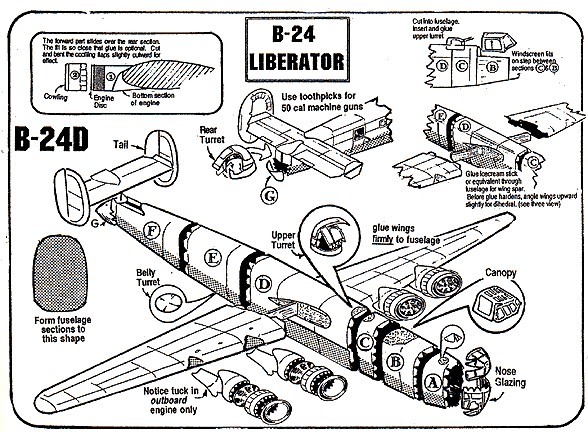
Readers with memories of World War II aircraft will recall the big, ugly, seemingly slow Consolidated B-24 Liberator. In the European theatre, of course, it was much over-shadowed by the Boeing B-17 Flying Fortress, and to those with no detailed knowledge of military aircraft it often comes as something of a shock to learn that not only was Consolidated's Liberator built in considerably greater numbers than the B-17, but it was the most extensively produced of the USA's wartime aircraft.
 The origins of the Liberator stretch back to the earlylmid-1930s,
an era in which projects such as the Boeing XB-15 and Douglas
XB-19, and development of the B-17, brought a far wider knowledge
and appreciation of the 'big bomber'. The Liberator represents
the next generation, its evolution spurred by the tense political
situation in Europe and the growing threat of Japanese militancy.
In January 1939 the US Army Air Corps invited Consolidated to
prepare a design study for a heavy bomber with performance superior
to that of the B-l7.
The origins of the Liberator stretch back to the earlylmid-1930s,
an era in which projects such as the Boeing XB-15 and Douglas
XB-19, and development of the B-17, brought a far wider knowledge
and appreciation of the 'big bomber'. The Liberator represents
the next generation, its evolution spurred by the tense political
situation in Europe and the growing threat of Japanese militancy.
In January 1939 the US Army Air Corps invited Consolidated to
prepare a design study for a heavy bomber with performance superior
to that of the B-l7.
Consolidated wasted little time in submitting a design proposal, identifying it as the Consolidated Model 32 and, as long range was paramount, it was designed round the Davis wing, first introduced on the company's Model 31 flying-boat design, of which a prototype was then nearing completion. In reaching a decision togo ahead with prototype construction of the Model 32, the US Army almost matched the speed set by Consolidated, and in awarding the contract on 30 March 1939 they maintained the tempo, insisting that construction of the prototype, designated XS-24, must be completed by the end of the year. This was achieved by the company, with the first flight being made on 29 December 1939.
In size the XB-24 was marginally smaller than the Fortress except in span; in terms of wlng.area that of the XB-24 was approximately 26 per cent less, emphasizing the high aspect ratio of the Davis wing, To ensure maximum capacity within the fuselage structure, the wing was high-mounted in shoulder wing configuration, and to provide good low-speed handling characteristics and an acceptable landing speed, wide-span Fowler-type trailing-edge flaps were fitted. Construction of the fuselage was conventional, but deep in section to allow for installation of a bomb bay which could accommodate up to 3629 kg (8,000 lb) of bombs stowed vertically. The bay was divided into two sections by the fuselage keel beam, this being utilized to provide a catwalk for crew transition between the fore and aft sections of the fuselage.
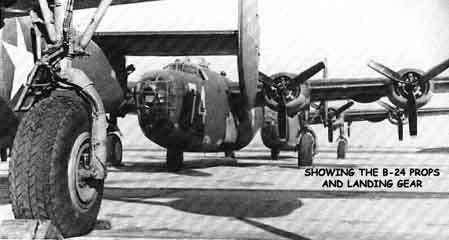 The most unusual feature
of the bomb-bay was the provision of unique 'roller shutter' doors
which retracted within the fuselage when opened for attack, causing
less drag than conventional bomb-bay doors. The tail unit, with
its easily recognizable oval-shaped endplate fins and rudders,
was generally similar to that developed for the Model 31 flying boat.
Retractable tricycle landing gear and four wing-mounted 895-kW
(1,200hp) Pratt & Whitney R-1830-33 Twin Wasp engines completed
the configuration.
The most unusual feature
of the bomb-bay was the provision of unique 'roller shutter' doors
which retracted within the fuselage when opened for attack, causing
less drag than conventional bomb-bay doors. The tail unit, with
its easily recognizable oval-shaped endplate fins and rudders,
was generally similar to that developed for the Model 31 flying boat.
Retractable tricycle landing gear and four wing-mounted 895-kW
(1,200hp) Pratt & Whitney R-1830-33 Twin Wasp engines completed
the configuration.
Even before the prototype had flown, Consolidated had begun to receive orders for its new bomber, These included seven of the service test Y~24 and 36 of the initial production S-24A models for the USAAC, and 120 aircraft 'off the drawing board' for a French purchasing mission. Early flight tests proved successful, but to meet the USAAC specification some development was necessary to achieve higher speed; however, there was no doubt that the XB-24 was able to demonstrate excellent long-range capability. Furthermore, the large-volume fuselage lent itself to adaptation to fulfil other roles and it was this versatility combined with long range that was the key to success for the B-24.
The XB-24 was followed during 1940 by the seven YB-24s for service trials, and these differed from the prototype by the provision of pneumatic dc-icing boots for the leading-edges of wings, tailplane and fins. By the time that the first production aircraft began to come off the line at San Diego, France had already capitulated, and the aircraft of the French order were completed to British requirements, as specified in an order for 164 which had been placed soon after that of 120 for France: the French order was later transferred to Britain.
 An example of neutrality markings is shown this transport Liberator, built against a British order and requisitioned by the USAAF. A pointed-out RAF roundel can be discerned on the fuselage, while on the top of the cabin is another US flag marking. Aircraft of this type shuttled about the world just before Pearl Harbor. |
 B-24 D, 93rd BOMB GROUP, USAAF, HARDWICK, UK, 1943 Standard Olive Drab and Neutral Gray finish with the short-lived red-outline to the national insignia, individual aircraft letter (N) on the lower fin and group symbol above, overlapping on to the rudder. This was the oldest B-24 Group in the 8th AF and flew more missions than any other unit. After the war the unit flew the B-29, B-47 and, more recently, the B-52 |
 B-24D-90 491st BOMB GROUP, USAAF, NORTH PICKENHAM, UK, AUTUMN1944 To assist the huge 8th AF bomber formations to form up in the right order and position, each group had a brightly-painted lead ship on which the rest of the unit would format. This done, the lead ship would head for home, leaving the group to the mission. Little Gramper is typical and, like most lead ships, was a war-weary aircraft. |
|
Anti U-boat patrols over the Atlantic was one of the tasks of these aircraft based in the west of England. Colors were non-specular Sea Blue on the top surfaces, intermediate blue on the vertical surfaces with Insignia white undersides. |
The USME began to receive its first B-24As and these, duplicating the role of the LB-3OAs in the UK were allocated first to equip the Air Corps Ferrying Command, operating similar services across the North Atlantic as those of RAF Ferry Command. The first true operational bomber version, however, was the Liberator Mk II (Consolidated LU-30L for which there was no USMF equivalent. It differed from the Liberator Mk I primarily by having the fuselage nose extended 0.79 m (2 ft 7 ml by the insertion of a 'plug', by accommodating a maximum crew of l0 and by the installation of Boulton Paul power-operated turrets, each housing four7.7-mm (0.303-in) machine guns in mid-upper and rear fuselage positions. The RAF received 139 of this version and when Nos 159 and 160 Squadrons began operations with their Liberators in the Middle East in June 1942, they were the first to deploy these aircraft in a bombing role. One aircraft of this batch (At504) became the personal transport of Britain's prime minister, Winston Churchill, operated under the name Commando.
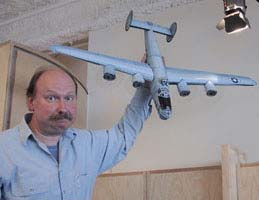 Meanwhile, the XB-24 prototype had been modified to a new XR-24B
standard, introducing self-sealing fuel tanks and armour, but
the most significant improvement was the installation of turbo charged
R-1830-41 engines. This resulted in the second of the Liberator's
easily identifiable features, oval-shaped nacelles, entailed by
the relocation of the oil coolers in the sides of the front cowlings.
With the introduction of these features, plus dorsal and tail
turrets each with two 12.7-mm 10,5-in) machine-guns to supplement
the original hand-held guns in beam and nose positions, nine aircraft
were produced for the USAAF with the designation R-24C.
Meanwhile, the XB-24 prototype had been modified to a new XR-24B
standard, introducing self-sealing fuel tanks and armour, but
the most significant improvement was the installation of turbo charged
R-1830-41 engines. This resulted in the second of the Liberator's
easily identifiable features, oval-shaped nacelles, entailed by
the relocation of the oil coolers in the sides of the front cowlings.
With the introduction of these features, plus dorsal and tail
turrets each with two 12.7-mm 10,5-in) machine-guns to supplement
the original hand-held guns in beam and nose positions, nine aircraft
were produced for the USAAF with the designation R-24C.
They were followed by the in-24D, the first major production variant and the first to be employed operationally by USMF bomber squadrons. This differed initially by the installation of R-1830-43 engines, but subsequent production batches introduced progressive changes in armament, provision of auxiliary fuel in the outer wings, increases in gross weight and bomb load, and in some late production examples external bomb racks below the inner wing for the carriage of two 1814-kg (4,000-Ib) bombs. In RAF service the B-24D was designated Uberstor Mk Ill: Uberator Mk EllA identified similar aircraft supplied under Lend Lease with US armament and equipment. Most Liberator Mk III/IIIA's served with Coastal Command, eventually equipping 12 squadrons. A total of 122 was modified extensively in the UK, receiving ASV radar equipment including chin and retractable ventral radomes, a Leigh Light for the illumination of targets at night especially surfaced U-boats), increased fuel capacity, but reduced armament, armour and weapon load. These were designated Liberator GA. Mk V.
Some were provided with small stub wings on the forward fuselage to carry eight rocket projectiles. The USMF also operated A-24Ds in an anti-submarine role, and in 1942 the US Navy began to receive small numbers of this version under the designation PB4Y-1. However, at the end of August 1943 the USAAF disbanded its Anti-Submarine Command, handing over its aircraft to the US Navy in exchange for an equivalent number of aircraft of bomber configuration to be produced against outstanding US Navy orders. These ex-USMF B-24s, which were equipped with ASV radar, were also designated PB4y-1 by the US Navy. This service later acquired the specially-developed PB4Y-2 privateer, which introduced a new tail unit with a single tall fin and rudder, a lengthened forward fuselage, changes in the armament to provide a maximum of 12 12.7-mm (0.5-in) machine-guns, and the installation of Pratt & Whitney R-1830-94 Twin Wasp engines without turbochargers.
The deployment of USAAF B-24Ds in the Middle East began in June1942, one of the first operations being launched by 13 aircraft against the Romanian oilfields at Ploesti on 11/12 June 1942. All 13 aircraft completed what the USAAF described as 'an unsuccessful attack. its only success being to alert the defenses of their vulnerability. Consequently, it was a very different story on 1 August 1943 when units of the 8th and 9thAirForces sent 177 B-24sagainstthe same target. Although rather more successful in terms of damage caused, of the force which set out from Benghazi 55 Liberators were lost, 53 damaged, and 440 crew killed or posted missing.
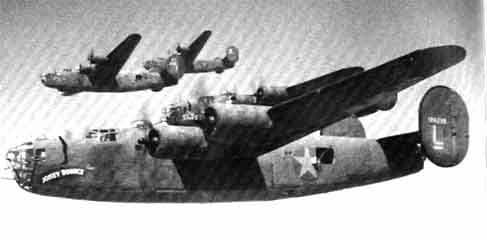
By that time, of course. B-24s were being built at an enormous rate, by Consolidated at San Diego and Fort Worth, Douglas at Tulsa, and Ford with a specially built new plant at Willow Run. In mid-1942 the first transport variants began to appear, with nose and tail gun positions deleted, a large cargo door installed in the port side of the fuselage, and accommodation provided for passengers or cargo. The USAAF acquired 276 under the designation C-87 with accommodation for a crew of five and 20 passengers; 24 similar aircraft, but provided with side windows, served with RAF Transport Command as the Uberetor C. Mk VII and examples flown by the US Navy were designated RY-2, Similar aircraft, but with R-1830-45 engines and equipped as VIP transports, were identified as NY-i and C-87A by the US Navy and USAAF respectively.
The US Navy also acquired 46 of a transport variant designated RY-3, and 27 similar aircraft were delivered in early 1945 for use by RAF Transport Command. One special logistics version was the C-lOB fuel tanker, used to ferry 10977 liters (2,900 US gal) of aviation fuel per load over the Himalayan 'hump', to supply Boeing B-29 Super fortresses operating from forward bases in China, An XF-7 prototype of a reconnaissance version was also produced in 1943, with bomb racks removed and extra fuel tanks provided in the forward section of the bomb bay. This retained the normal defensive armament, and could also accommodate up to 11 cameras. F-7s were used extensively in the Pacific theatre, and later versions included the F-7A and F-79 with differing camera installations.
The first production aircraft to come from the Ford plant at Willow Run was the B-24E, generally similar to the B-24D except for different propellers and minor detail changes, and this version was built also by Consolidated and Douglas, some having R-1830-65 engines. There followed the 9-24G. all but the first 25 of which introduced an upper nose turret and had the fuselage nose lengthened by 0.25 m (10 ml, These came from a new production line operated by North American Aviation at Dallas, Texas. Similar aircraft produced by Consolidated at Fort Worth, by Douglas and by Ford were designated 9-24H.
The major production variant was the B-24.J 16,678 built, which came from all five production lines, and which differed from the B-24H in only minor details. B-24H and B-24Js supplied to the RAF under Lend-Lease were designated Liberator GR. Mk V~ when equipped for ASW/maritime reconnaissance by Coastal Command, or Uberator B. Mk VI when used as a heavy bomber in the Middle East and Far East. Those used by the US Navy were identified as the PB4Y-1.
The final production versions were the 9-241, similar to the B-24D with the tail turret replaced by two manually controlled 12.7-mm (0.5-in) machine-guns, of which Consolidated San Diego built 417 and Ford 1,250; and the B-24M which differed from the B-24J in having a different tail turret. Convair built 916 of this latter version at San Diego and Ford another 1,677. Odd variants included a single B-24D provided with an experimental thermal de-icing system as the X9-24F; the XU-24K prototype of the single vertical tail version which it was intended should be produced in large numbers as the B-24N, although only the XB-24N prototype and seven YB-24N service test aircraft were built before production ended on 31 March 1945; the single experimental XB-41 bomber escort, armed with 14 12.7-mm (0.5-in) machine-guns and converted for flight engineer training under the designation AT-22 (later TB-241, Most of the USAAF's Liberators were declared war surplus at the war's end, only a few remaining in service and the very last of these was disposed of in 1953.
From first to last more than 19,000 Liberators had been built. In addition to those supplied to the RAF, USMF and US Navy, others had been operated by units of the Royal Australian Air Force, Royal Canadian Air Force and South African Air Force. Nowhere had they been of greater value than in the Pacific theatre, where their long range and versatility made them true 'maids of all work'.
Variant
ConvaIr Model SO~ this was an attempt to break into the post-war transport market, and took the form of the wings, powerplant and landing gear of the 6-24, the tail unit of the PB4Y-2 and a new fuselage able to carry 45 passengers or 5443 kg (12,000 lb) of freight; the sole prototype was evaluated by the US Navy as the R2Y.
Specifications
Crew: 7-10 |
 |
||
| A:The long span wing gave the B-24 excellent range and great performance al high altitude | B:Some late-model B-24s could carry bombs on racks under the inner wing. Antisubmarine versions in RAF service carried rockets. | C:The tricycle undercarriage was another modern feature of the B-24. |
 |
||
| A:The Bombardier sat in the glazed nose compartment, aiming his bombs with a Norden sight. | B:The deep fuselage was designed so the 4 ton bomb load could be stored vertically. A catwalk gave the crew access to the rear fuselage. | C: The gunner fired a pair of .50 caliber machine guns from a powered turret. |
